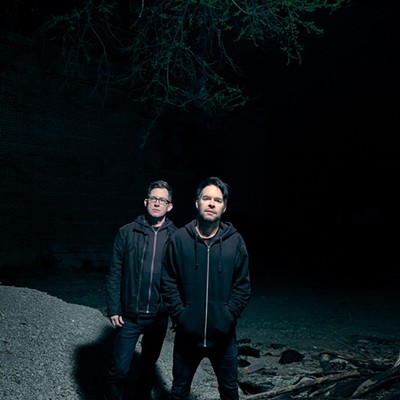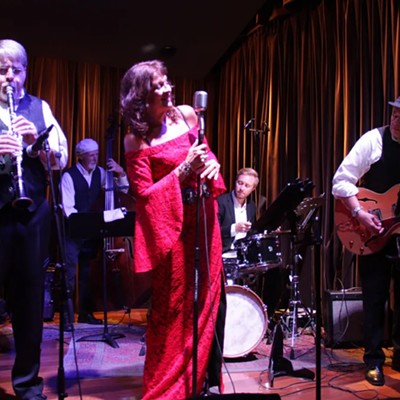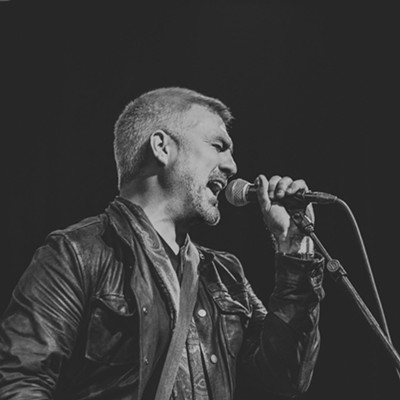Stephen Seigel: So, Gene, as two of the eldest statesmen as far as music critics in this town go, we've been charged with tackling the most important people, places and events in local music since the Weekly started 25 years ago.
Gene Armstrong: And I might even remember some of those years. But actually, that corresponds roughly with the amount of time I've been writing about music in Tucson. An auspicious milestone such as this allows us to indulge a little bit in nostalgia. And it's nice to do the point-counterpoint thing like James DiGiovanna and Bob Grimm, although we're probably not as funny as they are, or sexy, for that matter.
S.S.: No one is sexier than James DiGiovanna--or smarter. I first moved to Tucson in 1987, though I left for a few years in the interim. But I've got some indelible, if somewhat foggy, memories of what was going on when I got here. The first local band I really fell for was the Sidewinders, who, of course, later became the Sand Rubies. Their first album, ¡Cuacha!, which came out the same year I got here, was the first local album I bought. I came from a relatively small town with only a few decent local bands with really small followings, so those guys, who could draw a huge crowd, were like rock stars to me when I was 18. I had a fake ID that I used to get into places like the Tucson Garden to see them.
G.A.: Not that the Weekly would ever endorse breaking the law to hear music, right? Well, my memories of that band have been well-documented elsewhere, but also significant about the Sidewinders/Sand Rubies is that after that album was released, they got signed to RCA and became the first local act on a major label since groups like Bob Meighan and the Dusty Chaps in the 1970s.
S.S.: They, along with a couple of Phoenix bands, were really the spearheads of that slightly rootsy but powerful, guitar-driven sound that would later become known as "desert rock"--you know, all those bands the Europeans love. Hell, I think desert rock is still bigger in Germany today than it ever was here.
G.A.: I was in Germany and met some of those folks who love Tucson music, including one fellow who built an extension on his home to put up American bands overnight, especially the Sand Rubies, Luminarios and their ilk.
S.S.: Yeah, those Germans take it pretty seriously. But then, they take everything pretty seriously. The other bands that I saw a lot in those days were the River Roses, Al Perry and the Cattle, Pollo Elastico, The Host and the Phantom Limbs. I think the original Black Sun Ensemble was still playing. Al Foul and the Shakes. And then, of course, there was Thai Pink, who my friends and I used to make fun of. They later became the springboard for the Supersuckers. Not to mention Giant Sandworms and the two acts they spawned--Rainer Ptacek and Giant Sand.
G.A.: We can't underestimate the influence of Rainer, who was just about the kindest and most generous musician in town. He was willing to sit in with just about anyone if they asked. He really pioneered a different way of playing acoustic and electric blues, sort of filtered through his Bohemia-by-way-of-Chicago-cum-Tucson sensibility. What other local acts recorded with both Billy Gibbons and Robert Plant? He passed away in 1997, but there have been several posthumous releases, proving friends' and family's desire to keep him alive. His two sons also play music now, so he's got the legacy thing going for him.
S.S.: Every single time I saw Rainer, he absolutely blew my mind. Every single time, whether it was with a band or solo. Plus, when he would play solo, he'd use all those looping pedals, like a lot of people do now. But he was the first one I ever saw do it.
G.A.: Speaking of Giant Sand, that reminds me how important Howe Gelb and the various incarnations of his band have been to the local music community during the last 25 years. His music has blended everything from Americana, blues and country to noisy skronk to piano jazz. He's originally from Pennsylvania, but he's been an ambassador for Tucson music all over the world for a long time, and he's released oodles of albums--the first was the haunting Valley of Rain, in 1985.
S.S.: I think the first album I heard by Giant Sand that really killed me was probably Swerve. But, man, those live shows. They were always improvising and unpredictable, so occasionally, they'd fall on their asses--that's the cost of bravery--but when they were on, there was nothing like it. I remember, oh, maybe in the mid-'90s, when Giant Sand used to play free happy-hour shows every Wednesday at Club Congress. That was the lineup of Howe, John Convertino and Joey Burns, a couple of guys I imagine our readers have heard of.
G.A.: Nice segue there, Stephen! After meeting up in Giant Sand, Joey and John started Calexico and released their first album, Spoke, in 1997, to quiet acclaim, but they've grown in stature ever since, appearing on NPR and in all sorts of media outlets. They've also released a bunch of records since then and keep getting better and better, showing off Tucson music to the world and collaborating with all sorts of players. They're still true to where they came from, always a popular draw in Tucson and willing to play lots of benefits for righteous causes.
S.S.: Plus, they've absorbed mariachi and other regional music, and added it into their own sound. They sound more like Tucson to me than perhaps any other band. And they've recorded almost all of their stuff with Nick Luca and Craig Schumacher at his Wavelab Studio, which itself is a Tucson institution. Go, and look at the wall of CDs recorded there. It's astounding--great bands from all over the country come here to record there. I imagine it played something of a role in Neko Case moving here. She records all her stuff there.
G.A.: Weren't you just telling me the other day that you saw her play shows at Solar Culture Gallery? I've seen and heard her in some nice venues, but I'll bet she was great in there. I've got lots of fond memories of that venue.
S.S.: Oh, yeah, those shows were amazing. That place itself is amazing, one of my favorite places in town to see shows. Which brings up: Where would this town have been for the last 25 years without Steven Eye, who runs Solar Culture? Before that, he ran Dodajk Internation and the Downtown Performance Center, which during its run from 1991 to 1995 hosted an average of probably four great shows a week. If you saw a list of all the bands that played there, your head would explode. I think if I had to pick the person most influential to Tucson music over the last 25 years who isn't actually a musician, Steven Eye would be high on that list.
G.A.: Always loved the way Steve Eye has encouraged community in Tucson music circles, sometimes in the face of great adversity. He's not your garden-variety promoter, and he books acts because they mean something to him, not simply to make money. On top of that, he makes delectable vegetarian meals for all the bands that play there.
S.S.: And it's a completely different environment from seeing bands in bars. But as long as we're on the subject of bars, the one that has to have been the most consistently important is Club Congress, which will be celebrating its own 25th anniversary next year. It's certainly the place in town where I've seen the most shows. And one of the best times I ever had there was at the weekend-long 20th anniversary festival in 2005. It was like a rock 'n' roll high school reunion, and I got to see so many of my favorite local bands from over the years, not to mention a bunch of ones I got here too late to see the first time around.
G.A.: Now we sound like we're in a discussion group on Facebook. Poke! Anyway, that was a fine time--the reunions of Green on Red, River Roses and Pills/Gentleman Afterdark were a blast. I mean, I never went to any of my real high school reunions, but I made sure to hit Congress that weekend.
S.S.: Same here. And unlike a real class reunion, no one cared how bald or fat anyone had gotten. Seeing the Weird Lovemakers and Shoebomb reunions and those Bloat Records bands, like Mondo Guano, the Pork Torta and Doo Rag, the latter in the tiny women's bathroom at the Rialto--it was so packed and hot in there that the mirrors actually steamed up--were highlights for me. And that weekend also featured the world premiere of High and Dry, Michael Toubassi's documentary about the very same time period in the local music scene that we're talking about.
G.A.: I know that some people had issues with that movie--they argued about what was and wasn't included--but after all is said and done, I thought it was a pretty good document of a time, place and sound. And we were both in it!
S.S.: It's not easy cramming 25 years of history into a two-hour movie--or a single newspaper article, for that matter, as I think we're proving here. Yeah, I'm pretty sure that's the first and last time I'll ever see myself on the big screen, and believe me, I'm fine with that.
G.A.: While we're being self-serving, maybe this would be a good time to point out that the Tucson Weekly's TAMMIES (aka Tucson Area Music Awards) and Club Crawl™ events have been big contributors to local music.
S.S.: A little horn-tooting won't kill us. The Crawls are still the largest local music event around. And we should also mention the Rialto Theatre, which, since it reopened in 1995, has become kind of the hub of those events.
G.A.: Yeah, big props are due Jeb Schoonover and Paul Bear for reopening that joint, and to (Tucson Weekly founder) Doug Biggers, who took it over and now runs the place, along with booker extraordinaire (and Weekly contributor) Curtis McCrary.
S.S.: That place has really transformed the music scene, too, because it allows acts that are too big for places like Congress and Vaudeville, Plush and The Rock--all of which consistently do great shows on that level--to have a place to play; that had been missing from Tucson ever since the roof blew off El Casino Ballroom. I still have a poster for a show that was scheduled to take place there, but was canceled because the roof blew off: Pere Ubu opening for the Pixies.
G.A.: El Casino is open again, although in a smaller form. But it was the location for many excellent shows back in the 1980s and early '90s, including the Dead Kennedys, H.R. from Bad Brains, Los Lobos and many a KXCI "house-rockin'" concert--coincidentally, those usually were promoted by Bear and Schoonover. Those guys have had a big impact on music in Tucson.
S.S.: For sure. Schoonover still promotes the TAMMIES and Club Crawl™, and Bear was one of the founders of KXCI.
G.A.: And, by the way, community radio station KXCI FM 91.3 also recently celebrated its 25th anniversary. (Full disclosure: I am a volunteer DJ for the station.)
S.S.: Nice segue, Gene! I'd be willing to wager there's no better radio station in the country as far as being so good to its local acts. Also, how great was the free-form pirate station Radio Limbo while it lasted? Best. Station. Ever.
G.A.: Again with the illegal stuff! Actually, I dug Limbo, too--everything about it was a lot of fun. But it should be noted that the Tucson Weekly in no way endorses the operation of nonlicensed radio stations. However, we do like punk rock, and we haven't mentioned that much yet, have we?
S.S.: No, you're right. Tucson has a long history of great punk bands, from UPS and Bloodspasm and FUCT, to Malignus Youth, The Fells and Los Federales, just to name a few.
G.A.: We've been doing an awful lot of reminiscing, but there's been some great music in recent years, too. A lot of the acts playing now may become the movers and shakers of the next 25 years.
S.S.: Sure. We've got labels like Stunning Tonto and Mudhouse putting out records by people like Tom Walbank, Chango Malo, Fourkiller Flats ...
G.A.: Allow me to interrupt you there and add that Walbank's Sugarmama is one of my fave local albums of the last 25 years. Please proceed.
S.S.: I could go on and on. The Okmoniks are on Slovenly. Bob Log III is on Fat Possum. Golden Boots are on Park the Van. Digital Leather is on Goner. The Bled is on Vagrant. They're all national as well as local acts now. But no matter how many local bands make it to the national level, Tucson will always have a certain sort of outsider mentality, which in turn gives bands a lot of freedom. And let's not forget that The Bled came out of Skrappy's, which nurtured a lot of young bands by giving them a place to play and develop. The Living Room and Dry River are good like that, too. Plus, Skrappy's is going to be reopening before too long, and I'm sure you'll be able to see some bands at the new location that someone--hopefully not us--will be writing about in the Weekly's 50th anniversary issue. Assuming that music still exists then.
G.A.: What say we resume this conversation in 2034?
S.S.: Oh, all right. You're on.







